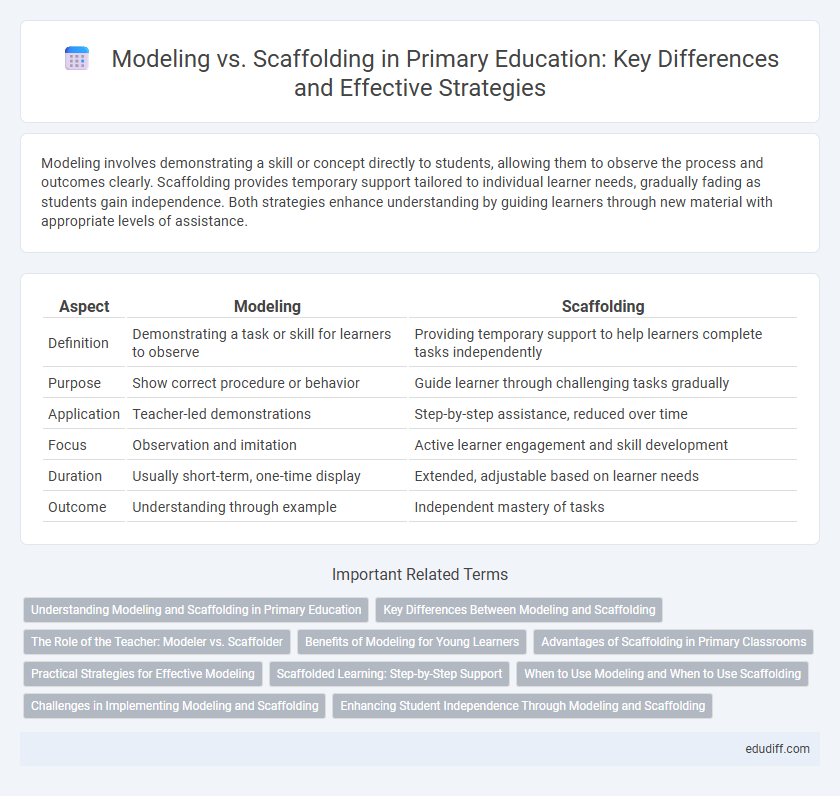Modeling involves demonstrating a skill or concept directly to students, allowing them to observe the process and outcomes clearly. Scaffolding provides temporary support tailored to individual learner needs, gradually fading as students gain independence. Both strategies enhance understanding by guiding learners through new material with appropriate levels of assistance.
Table of Comparison
| Aspect | Modeling | Scaffolding |
|---|---|---|
| Definition | Demonstrating a task or skill for learners to observe | Providing temporary support to help learners complete tasks independently |
| Purpose | Show correct procedure or behavior | Guide learner through challenging tasks gradually |
| Application | Teacher-led demonstrations | Step-by-step assistance, reduced over time |
| Focus | Observation and imitation | Active learner engagement and skill development |
| Duration | Usually short-term, one-time display | Extended, adjustable based on learner needs |
| Outcome | Understanding through example | Independent mastery of tasks |
Understanding Modeling and Scaffolding in Primary Education
Modeling in primary education involves demonstrating tasks or behaviors explicitly to help students grasp new concepts, while scaffolding provides temporary support structures that guide learners toward independent problem-solving. Both strategies enhance comprehension and skill acquisition by aligning instructional support with students' developmental levels. Effective use of modeling and scaffolding fosters active engagement, deeper understanding, and gradual mastery in young learners.
Key Differences Between Modeling and Scaffolding
Modeling involves demonstrating a task or behavior for learners to observe and replicate, emphasizing direct example-setting to build understanding. Scaffolding provides temporary support tailored to the learner's needs, gradually removed as competence increases to foster independent problem-solving. Key differences include modeling's focus on showing "how" versus scaffolding's support structure that adapts to learner progression.
The Role of the Teacher: Modeler vs. Scaffolder
The teacher as a modeler demonstrates specific skills or tasks, providing clear examples for students to imitate, which supports initial learning through observation and practice. In contrast, the teacher as a scaffolder offers guided assistance, gradually reducing support as students develop independence and confidence in their abilities. Effective teaching often combines both roles, adapting to the learner's evolving needs to optimize skill acquisition and comprehension.
Benefits of Modeling for Young Learners
Modeling supports young learners by demonstrating language use in authentic contexts, enhancing vocabulary acquisition and pronunciation accuracy. It provides clear examples of sentence structures and communication strategies, promoting stronger language retention and confidence. This approach also encourages imitation and practice, which are essential for developing fluency and comprehension skills efficiently.
Advantages of Scaffolding in Primary Classrooms
Scaffolding in primary classrooms supports individualized learning by providing tailored guidance that addresses each student's current abilities and gradually increases complexity. It enhances student engagement and confidence by breaking down complex tasks into manageable steps, promoting active participation and deeper understanding. This approach fosters independence and critical thinking, preparing young learners for future academic challenges through structured support.
Practical Strategies for Effective Modeling
Effective modeling involves demonstrating tasks step-by-step to provide clear examples, helping learners visualize the desired outcome and processes. Incorporate think-aloud techniques to explain reasoning and decision-making transparently, enhancing comprehension. Using diverse media such as videos or live demonstrations caters to different learning styles, increasing engagement and retention.
Scaffolded Learning: Step-by-Step Support
Scaffolded learning provides step-by-step support that gradually builds a learner's independence by breaking complex tasks into manageable parts. This approach ensures continuous guidance through prompts, questions, and feedback tailored to the learner's current level of understanding. Effective scaffolding enhances skill acquisition and confidence by adapting the amount of assistance as learners progress.
When to Use Modeling and When to Use Scaffolding
Modeling is most effective when introducing new skills or concepts, allowing learners to observe and internalize expert performance before practice. Scaffolding is ideal when learners have a basic understanding and need guided support to complete tasks independently, progressively reducing assistance as competence grows. Selecting between modeling and scaffolding depends on the learner's prior knowledge and the complexity of the skill being acquired.
Challenges in Implementing Modeling and Scaffolding
Challenges in implementing modeling include ensuring accurate representation of complex concepts and maintaining learner engagement through clear demonstrations. Scaffolding difficulties involve balancing support with independence to avoid learner dependency while effectively fading assistance as skills develop. Both require continuous assessment to tailor strategies to individual learner needs and cognitive levels.
Enhancing Student Independence Through Modeling and Scaffolding
Modeling provides students with clear examples of expected skills and thought processes, enabling them to internalize and replicate effective strategies independently. Scaffolding gradually transfers responsibility to learners by offering structured support tailored to their current abilities, promoting confidence and autonomy as the support diminishes. Combining both approaches enhances student independence by building competence through observation and guided practice, leading to sustained academic growth.
Modeling vs Scaffolding Infographic

 edudiff.com
edudiff.com